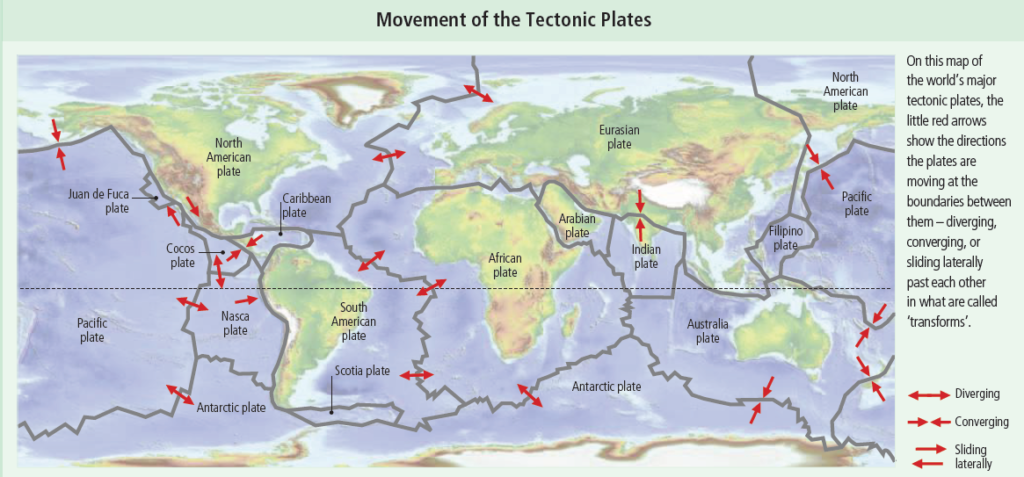The division of the world into land and sea seems so
natural and timeless that it is hard to imagine it any other
way. Yet the very existence of continents and oceans is unique to
planet Earth, and their behaviour is even more remarkable.
Early in the 20th century, a German meteorologist named
Alfred Wegener noted the extraordinary way coastlines of
continents seemed to match across the oceans, like the separated
pieces of a vast jigsaw. He suggested that this was because the
continents were once joined together and the oceans between
them opened up as they split apart and drifted around the
world over many millions of years. For a long time, the idea
was considered too weird for serious geologists to contemplate,
but in the years after World War II, a rising tide of evidence,
including matching fossils found on continents an ocean
apart, broke down their resistance.
Going continental
By the 1960s, geologists were convinced of the reality of
‘continental drift’ – the idea that the continents have moved
right around the Earth, breaking apart and coming together.
Today, incredibly accurate satellite laser ranging measures this
movement in real time. On average, it is no more than 1 cm
(0.4 in) a year – no faster than a fingernail growing. But on the
geological timescale that is fast enough to redraw the world
map completely over and over again – fast enough to open up
the entire Atlantic Ocean in just 40 million years. The process is
ongoing. As you read, New York is moving farther from London.
A turning point in the case for continental drift was the
discovery of a mechanism that could make it happen, a
discovery that was even more astounding in its implications than
continental drift. It is not just the continents that are on the move,
but the entire surface of the Earth, and the continents are simply
swept along on them like so many goods on a conveyor belt.
In fact, the Earth’s surface, far from being a complete shell, is
cracked into huge slabs or ‘tectonic plates’. Each of these slabs
is a thick chunk of ‘lithosphere’, the cool, rigid outer layer of
the Earth topped by the crust. The scale of some of these plates
is vast. They are typically just 100 km (60 miles) thick but some
of them encompass entire oceans or continents. There are dozens
of moderate-sized plates and seven gigantic ones. The biggest
of all, the Pacific plate, underlies most of the Pacific Ocean.

It is the only plate that is entirely oceanic. The others – Eurasian,
African, Indian, Australian, North American, South American,
and Antarctic – carry continents as well as forming the ocean bed.
The Earth does move
It seems hard to imagine how such vast slabs of rock could ever
move, yet they are moving all the time. What is more, they are
not even permanent features of the Earth’s surface. The cores of
continents are stable and very ancient, often containing rocks
that are billions of years old, and they preserve intact the plates
on which they ride over aeons of time. But they are islands in
a turbulent world. All around, under the oceans, the plates are
continually breaking apart and fusing together, growing at the
edges as new molten rock welling up from the interior is welded
onto them, or destroyed when driven against the continental
plates and thrust underneath into the Earth’s hot interior.
The old continent
What is especially interesting is just how different the continents
are geologically from the ocean floor. The continents are
essentially chunks of ancient granite-like rock – pale in colour
and light in weight – and the oldest pieces are almost four billion
years old (the Earth is about 4.6 billion years old). The ocean
floor, however, is mostly young basalt rock, dark and dense, and
mainly just a few tens of millions of years old.
The basalt that forms the bulk of the Earth’s crust forms when
magma (molten rock) wells up from the Earth’s warm mantle
to cool and turn solid at the surface. The granite in continents
cannot form directly from mantle melts like this. Instead, it
forms when basalt remelts, changing its chemistry and mixing
with other substances met at the surface. Long ago, when the
Earth was young, all the Earth’s surface was as changeable
and impermanent as the ocean floor. But gradually parts of
it remelted and coagulated to form these chunks of granite.
You could say that the continents are the scum of the Earth.
Unlike the ocean floors, which go through a continual cycle
of renewal and decay, the continents survive through the ages
because they float on top of the denser basalt and so, unlike
basalt, are never dragged down to destruction in the mantle again.
Most of the geological action goes on beneath the sea, while the
continents rise above it all. That is of course what makes the
oceans such an extraordinary place for life.


